How to make dehydrated grape tomatoes using your garden fresh tomatoes or store bought tomatoes. Do you love the flavor of fresh tomatoes?
Food dehydrator recipes will have you could enjoying them all year long. Check out how you can preserve fresh grape tomatoes and have them last for years in your food storage.
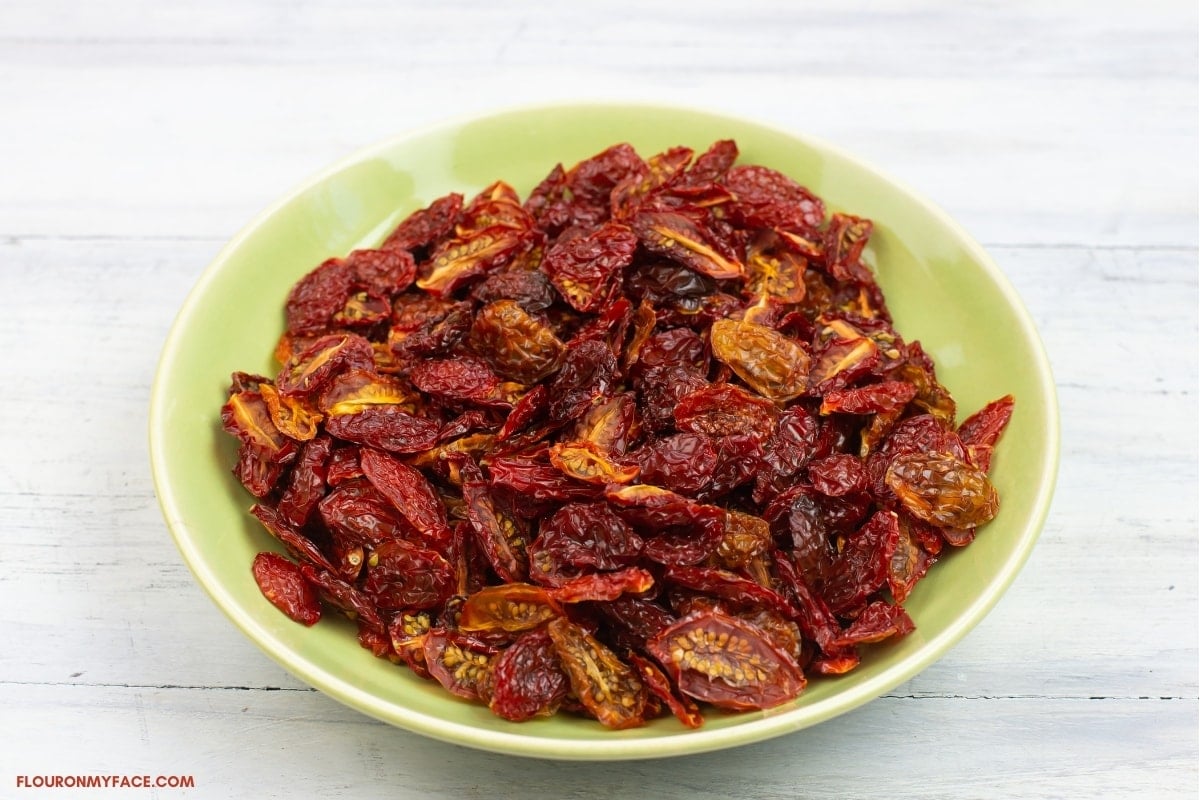
Dehydrating tomatoes is an easy way to preserve the end of season fresh tomatoes you have been growing in your garden this year.
Once dehydrated grape tomatoes are dried properly and stored properly they can last anywhere from a few months to years.
If you are trying to stock your winter pantry with the flavors of summer dehydrating is the perfect food preservation method to use.
If you don't have a garden but want to preserve the flavors of fresh grown tomatoes to enjoy over the winter months you can buy bulk tomatoes at the farmers market or grocery store to dry.
Today I am sharing how I am drying grape tomatoes in a dehydrator. I bought the grape tomatoes at the store since I did not grow a garden this summer.
Jump to:
- FREE Dehydrator Guide
- FAQ
- Equipment Needed
- What kind of dehydrator do you need?
- Ingredients
- Prep Work
- What temperature to dehydrate tomatoes
- Steps to make Dehydrated Grape Tomatoes
- How to make sure the dehydrated tomatoes are done?
- How To Store Dehydrated Tomatoes
- How To Use Dehydrated Tomatoes
- More Dehydrating Recipes
- How To Dehydrate Grape Tomatoes
FREE Dehydrator Guide
New to dehydrating and not sure where to start? Grab my free Dehydrating Quick Guide to get started.
The Florida summers are too hot and wet to grow tomatoes. We wait for the cool and dry winter months to plant tomatoes.
I will be growing a couple of varieties of tomatoes this winter growing season so I can have a supply of tomatoes to use in my cooking all year long.
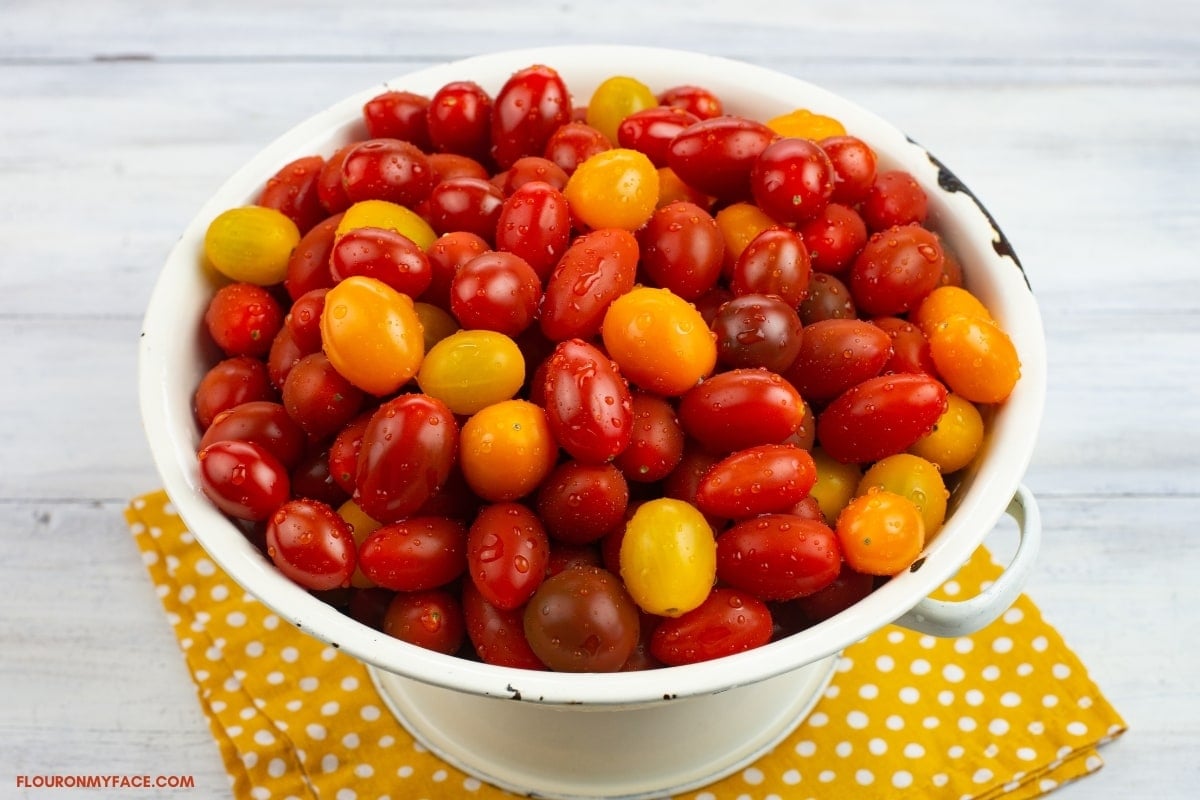
FAQ
Yes, grape, cherry and large varieties of tomatoes can be dehydrated. 
Dehydrated tomatoes can be rehydrated and used the same way you would use fresh tomatoes. Or you can eat the dried tomatoes as a crispy savory snack. Dehydrated tomatoes can also be added to recipes calling for tomatoes.
The length of time dehydrated grape tomatoes will last will depend on the storage method you use. Stored in plastic bags or containers and the dehydrated tomatoes with last 6 months or longer is stored in a dark cool cabinet. When storing dehydrated tomatoes in vacuum sealed jars or bags you can extend the storages time to years.
Equipment Needed
- Food Dehydrator
- mesh screen dehydrator tray liners
- sharp knife
- cutting mats or cutting board
- airtight containers for storage I've been using quart canning jars.
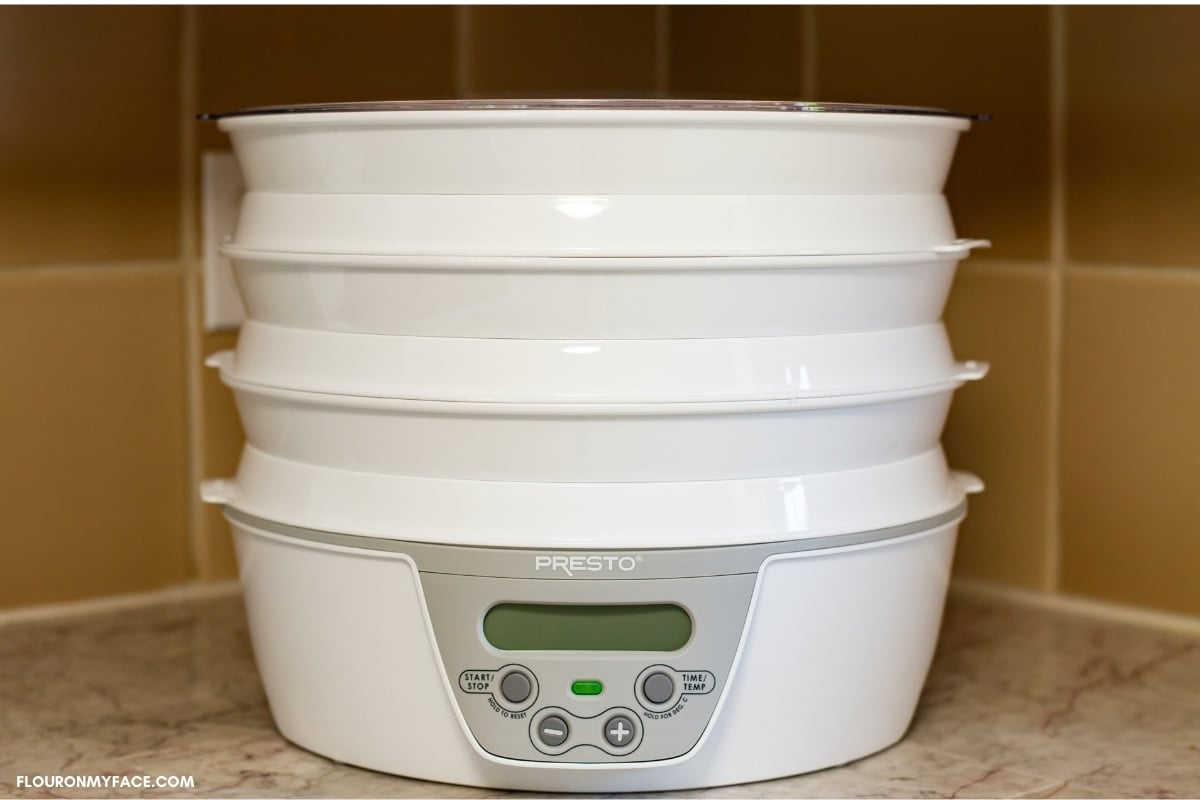
What kind of dehydrator do you need?
I've mention this a number of times in the past and need to emphasis it again. You do not need an expensive food dehydrator to dehydrate foods.
I started dehydrating over twenty years ago with an inexpensive round dehydrator that cost about $30 back then.
Today I am still using a round dehydrator that cost about $70 because I recently updated to one with a temperature setting and timer.
I would love a Excalibur dehydrator because you can pack more stuff in those nine trays but until I find one for a very good price I will not be upgrading.

Ingredients
- 4 to 5 pounds of fresh grape tomatoes

Prep Work
- Rinse the tomatoes under cold water to remove any dirt.
- For small tomatoes like grape or cherry tomatoes use a sharp knife to cut them in half horizontally.
- For larger cherry tomatoes you can cut them into small wedges. Keep in mind that the thicker wedges of tomato will take longer to dry completely.
Fresh Tomatoes
Homegrown or store bought tomatoes can be used. If you have a garden you can pick the tomatoes right off the plant, rinse well under cold water and drain to remove as much moisture as possible from the freshly washed tomatoes.
There are a bunch of types of grape tomatoes available to the home gardener. If you are growing grape tomatoes you know what a heavy bearer grape tomato plants can be.
If you have purchased grape tomatoes you will do the same thing to clean the grape tomatoes before drying them in your food dehydrator. The less moisture the tomatoes have on them the quicker they will dehydrate.
What temperature to dehydrate tomatoes
Grape tomatoes should be dehydrated at 125 degrees Fahrenheit for about 18 hours. If you do not have a temperature control it is likely that your dehydrator runs at about 165 degrees Fahrenheit.
At 165 degrees it will take less time for the tomatoes to dehydrate. You will need to keep a closer eye on them to make sure they do not over dry.
Steps to make Dehydrated Grape Tomatoes
- Prepare the fresh tomatoes by washing under cold water.
- Slice the grape tomatoes in half horizontally.
- Line each dehydrator tray with a mesh liner.
- Arrange the grape tomato halves on a dehydrator tray cut side down, leaving about ¼ inch between each piece of tomato.
- Fill as many trays as you have sliced tomatoes.
- Stack the trays following the directions in your dehydrator manual.
- If using a dehydrator that has a temperature control setting set the temperature to 125 F. or the vegetable setting.
- Dehydrate the grape tomatoes for 12 to 18 hours or until the tomatoes pieces are hard, crisp and completely dry. They should not be sticky to the touch.
- Allow the tomato pieces to cool completely before storing in an air tight glass jar or container.
- Condition the dehydrated tomatoes by placing the container away from sunlight in a cool cabinet or pantry. Shake the jar once a day for one week to ten days. Check to make sure no moisture forms on the inside of the jar. If moisture does form immediately return the tomato pieces to the dehydrator to dry completely. If no moisture forms store the container in a cabinet away from direct sunlight that is cool and dark until ready to use.
- Vacuum seal the jar to extend the storage time for a year or longer.

As your dehydrator is running you will need to occasionally rearrange the trays.
I do this every couple of hours until the dehydrating tomato pieces are completely dry. If some of the smaller pieces are done I will remove them from the dehydrator as they finish.
Switching the position of the trays will help make sure all the tomato pieces are drying evenly and that the majority of them are done at the same time.
How to make sure the dehydrated tomatoes are done?
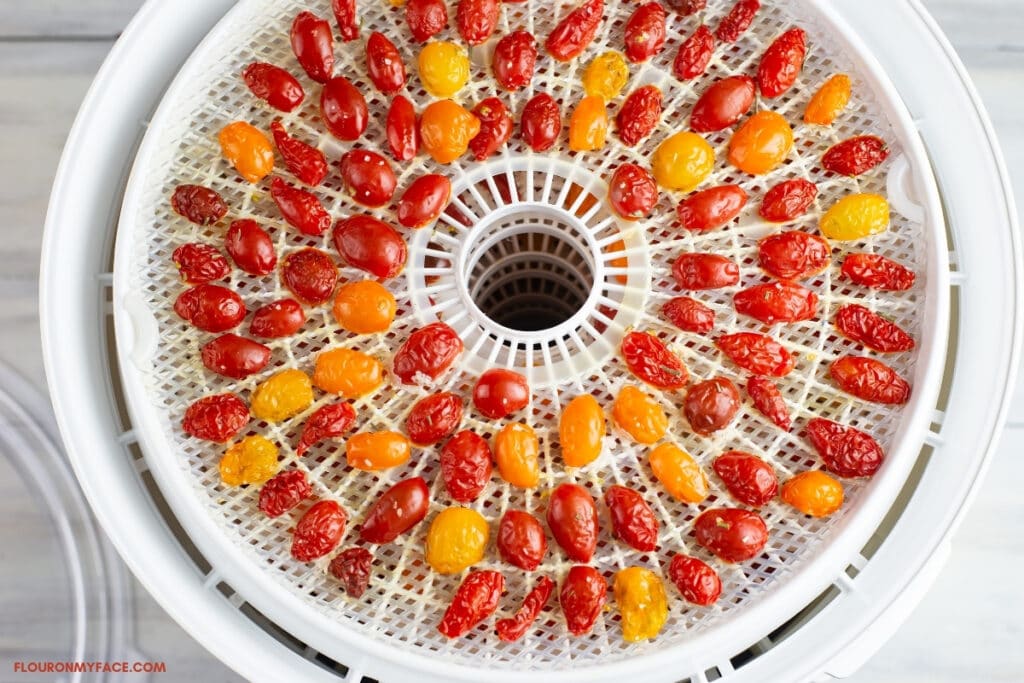
As the moisture is removed from the grape tomatoes they will begin to wrinkle and shrink.
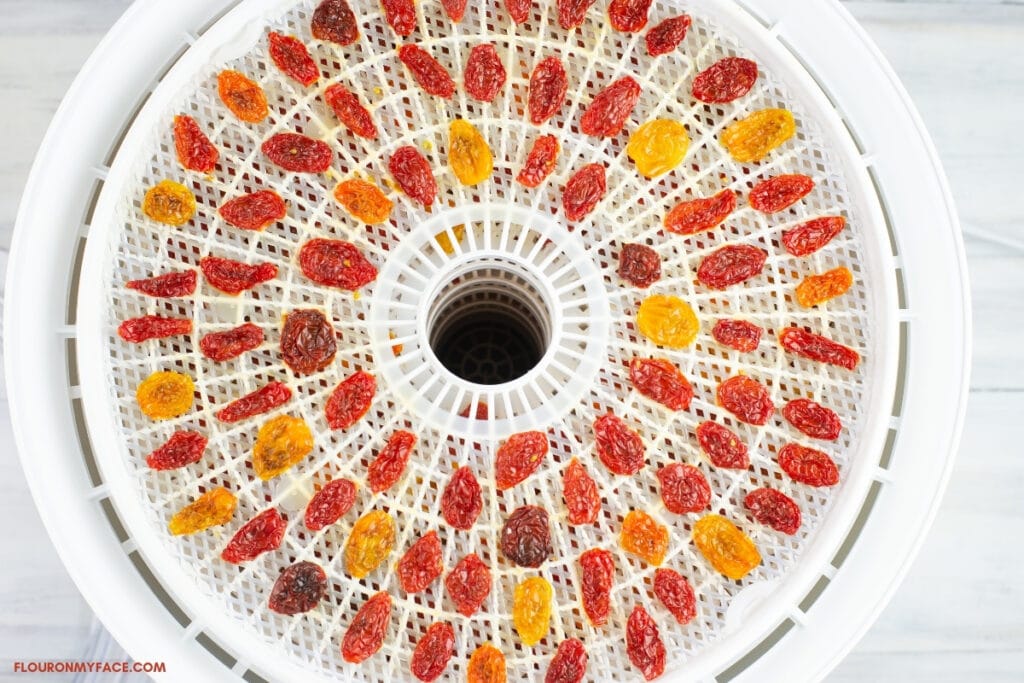
You can tell when the tomato pieces are completely dry because they will be crisp to the touch and have shrunk to almost half the size.
It is important to make sure that the center of each piece of tomato is dried all the way through.
The only way to do this it to pick up each piece of tomato and apply gentle pressure to the center. Check to make sure the piece is not sticky or tacky.
You will immediately know when a piece is not completely dry. The center of the tomato will feel mushy. Put it back in the dehydrator and continue until completely dry.
How To Store Dehydrated Tomatoes
When it comes to storing dehydrated grape tomatoes or any type of dehydrated food the food storage container/type and storage method used is really important.
It really makes a difference in how long you can store the dried food. Below I break down the pros and cons of the different storage methods for dehydrated foods. As you can see the storage time can run from about 2 months to 20 years depending on the method.
Plastic baggies
- Pros: Plastic baggies are convenient, easy to buy and inexpensive.
- Cons: Plastic baggies offer the shortest storage time of all the methods. Dehydrated foods will only last about 2 to 3 months when stored in zip topped plastic bags.
Plastic food grade containers
- Pros: Plastic food grade containers are also easy to buy and inexpensive. They can be bought in bulk for a very reasonable price. They are inexpensive, unbreakable and food safe.
- Cons: Plastic food containers will also offer you only a couple of months of storage time before the food starts to degrade. They are more airtight than baggies so if you are not opening and closing the container very often you may get another month of storage.
Glass canning jars
Canning jars are one of my favorite ways to store my dehydrated fruits, vegetables and herbs. You can buy plastic mason jar lids that are airtight twist on lids for regular mouth and wide mouth canning jars or you can use the flat lid and ring that comes with a case of canning jar.
- Pros: Glass canning jars will last for ever. The lids are usually easy to find. They are airtight. They are easily stored in a pantry or cabinet. The are available in many shapes and sizes. Foods will last up to a year or longer. You can vacuum seal the jars with a vacuum sealer and extend the shelf life of your dehydrated food up to 10, 15 and in some cases 20 years.
- Cons: Canning jars are hard to come by these day. There is a shortage. They are breakable. The larger jars take up a lot of space.
Vacuum sealed bags
- Pros: Properly dried and stored dehydrated foods stored in a vacuum sealed bag can last up to 20 years or longer when stored in a dark cool cabinet. The bags are available in many sizes. You can store them flat and save space.
- Cons: A vacuum sealing system is an investment. A decent food vacuum sealing system costs about $300. You can buy cheaper models but they are usually just a standard vacuum sealer without and of the bells and whistles. You have to replace the vacuum seal bags as you need them. They are usually only used once.
How To Use Dehydrated Tomatoes
There are a number of ways you can use dehydrated grape tomatoes. It depends on how you like to eat tomatoes and how you use them in your favorite recipes. Here are a few ideas on how you can use your dehydrated grape tomatoes.
- Dehydrated grape tomatoes are a great savory snack. You can snack on them just like you would snack on kale chips.
- You can season grape tomatoes with fresh rosemary and sea salt before you dehydrate them for added flavor. They taste amazing. Its like a tiny tomato chip.
- You can rehydrate the dried grape tomatoes and add them to salads, soups and stews. If you are adding them and cooking them in a soup or stew you can skip the rehydrating step. The dehydrated tomatoes will absorb the liquid as they cook with the soup or stew ingredients.
- You can use a blender or a grinder to make tomato powder. You can sprinkle the tomato powder in smoothies, on top of dishes or into the pot with a soup or stew to add some tomato flavor.
- You can also add water to the dehydrated tomato powder and end up with a thick tomato paste that you can add to a pot of sauce or other recipe for tomato flavor.
- You can make sundried tomatoes by covering the sliced dehydrated tomatoes with olive oil and adding fresh herbs and spices. Then make Sun Dried Tomato Dressing.
More Dehydrating Recipes
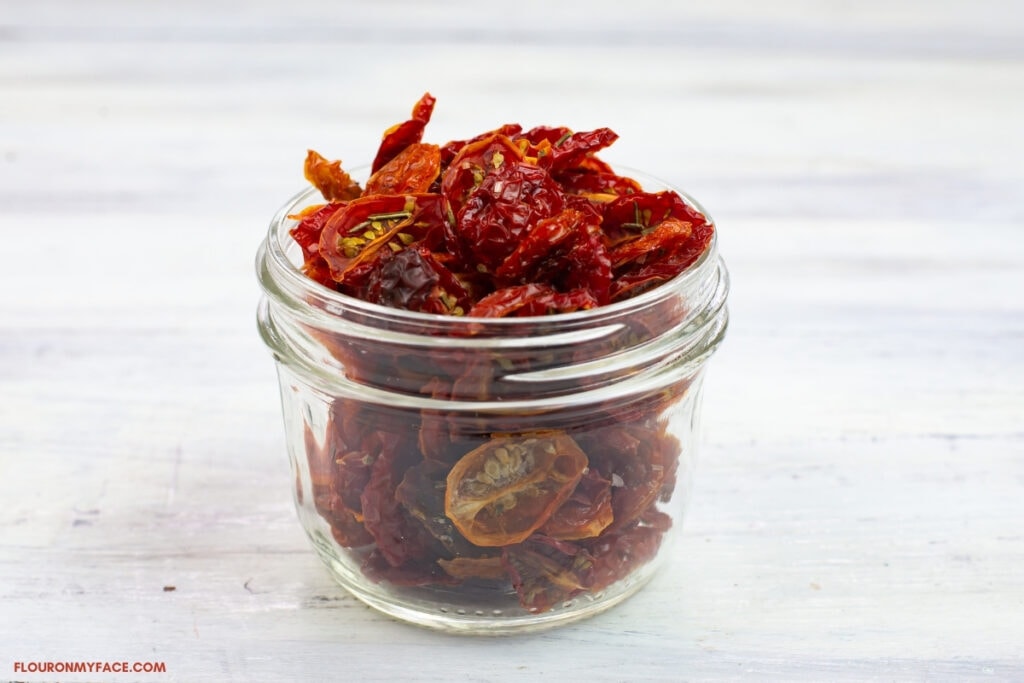
Email questions or recipe requests to flouronmyface@gmail.com. Follow me on Pinterest, YouTube, Instagram and Facebook.

How To Dehydrate Grape Tomatoes
Ingredients
- 4-5 lbs. grape tomatoes
- water
Instructions
- Prepare the fresh tomatoes by washing under cold water.
- Slice the grape tomatoes in half horizontally.
- Line each dehydrator tray with a mesh liner.
- Arrange the grape tomato halves on a dehydrator tray cut side down, leaving about ¼ inch between each piece of tomato.
- Fill as many trays as you have sliced tomatoes.
- Stack the trays following the directions in your dehydrator manual.
- If using a dehydrator that has a temperature control setting set the temperature to 125 F. or the vegetable setting. Dehydrate the grape tomatoes for 12 to 18 hours or until the tomatoes pieces are hard, crisp and completely dry. They should not be sticky to the touch.
- Allow the tomato pieces to cool completely before storing in an air tight glass jar or container.
- Condition the dehydrated grape tomatoes by placing the container away from sunlight in a cabinet or pantry. Shake the jar once a day for one week. Check to make sure no moisture forms on the inside of the jar. If moisture does form immediately return the tomato pieces to the dehydrator to dry completely. If no moisture forms store the container in a cabinet away from sunlight until ready to use.
- Store in zip lock bags, or air tight containers. Vacuum seal the jar to extend the storage time for a year or longer.
Video
Recipe Expert Tips
- Serving sizes will vary.


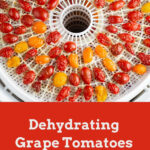



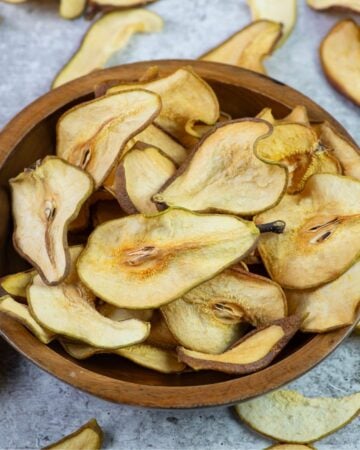

Leave a Reply